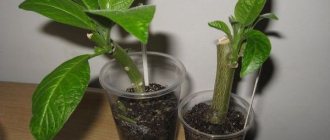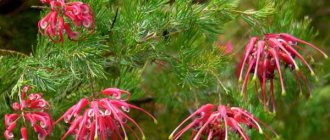The rosemary plant (Rosmarinus) is part of the Lamiaceae family. This genus is represented by evergreen shrubs and subshrubs. Under natural conditions, this plant can be found in such European countries as Portugal, Italy, Spain, Greece, in the southern part of France and in the countries of the former Yugoslavia, as well as in North Africa: Tunisia, Libya, Morocco, Algeria, as well as in Turkey and in Cyprus.
From Latin, “rosemary” is translated as “sea freshness”, this is explained by the fact that the ancient Greeks associated rosemary with the sea Aphrodite, who appeared from sea foam. However, the smell of this plant is not at all similar to the iodine sea aroma. It is more like a combination of the smell of camphor and pine, so the Greek name of the plant, translated as “balsam bush,” is closest to the truth. People used to believe that rosemary helped improve memory; therefore, in Ancient Greece, students often put wreaths on their heads, which were woven from rosemary branches. In culture, this plant has become popular due to its special aroma. This plant is included in the “bouquet garni” and the collection of Provençal herbs, and is also added to drinks, marinades, and vinegar is infused with rosemary. This evergreen shrub is distinguished by its heat-loving nature, so it can be grown in open ground only in those regions where winters are warm. And in those countries where the climate is cool, rosemary is grown as a container and indoor crop.
Brief description of cultivation
- Landing . Rosemary seeds are sown for seedlings in the last days of February or the first days of March, and the seedlings are transplanted into open ground from mid to late May.
- Illumination . A large amount of bright sunlight is needed.
- Soil . Calcareous, well permeable to water and air.
- Watering . Should be moderate. Water is poured carefully under the root to avoid drops falling on the surface of the leaf blades.
- Fertilizer . In spring, nitrogen-containing fertilizer, for example, urea or ammonium nitrate, is added to the soil on the site. After this, once every 30 days, rosemary is fertilized with a solution of complex mineral fertilizer. In autumn, fertilizers that contain only phosphorus and potassium are used.
- Reproduction . By cuttings, dividing the bush, seeds and layering.
- Harmful insects . In indoor conditions - whiteflies and aphids, in open ground - aphids.
- Diseases . In winter, in indoor conditions, the plant can get downy mildew.
Use in traditional medicine and contraindications
The chemical composition of the plant is very wide; it contains various acids, essential oils, trace elements, vitamins, and so on. Therefore, people from early times used it to get rid of various health problems:
- to improve memory and mood;
- to strengthen immunity;
- to remove accumulated toxic substances;
- for wound healing;
- to speed up metabolism;
- for the treatment of inflammatory diseases;
- to lower cholesterol and so on.
Rosemary is beneficial for both men's and women's health. Pregnant women can use it in small quantities if they have no other contraindications. It is recommended for people to limit the use of the seasoning or even abandon it and medicines made on its basis:
- with high blood pressure (hypertension);
- suffering from epileptic seizures;
- nursing mothers;
- children under 5 years of age.
Regardless of whether the spice enters the child’s body directly with food or through mother’s milk, it can cause cramps, insomnia, and lead to increased excitability.
Features of rosemary
Rosemary is a shrub whose height can vary from 0.5 to 2 meters. Its root system is very powerful and developed, it penetrates the soil to a depth of 3–4 meters. There is pubescence on the surface of the grayish obtuse tetrahedral young shoots. Perennial woody stems with peeling bark are dark gray in color. Sessile linear leaf blades are leathery to the touch and have downward curved edges. The leaves reach about 0.4 cm in width and up to 3.5 cm in length, their front surface is glossy, and the back surface is pubescent. Lush panicle-shaped inflorescences consist of flowers of pale purple, dark purple or white. This plant is a relative of the following crops: hyssop, basil, lavender, mint, motherwort, thyme (thyme), oregano and lemon balm. The upper parts of annual shoots, along with foliage and flowers, are used fresh, adding to dishes of legumes, cabbage, eggplant and meat.
Rosemary. Reproduction and cultivation.
When to replant?
Always plan to transplant your rosemary in the spring. Early is better, but you can move a little closer to summer.
It is necessary to replant rosemary, as the plant has a very powerful root. The preferred method for work is, of course, transshipment.
So, young rosemary will have to be replanted at least once a year. And already at 4-5 years of life, transplantation gradually becomes less frequent. Fully mature plants can be transplanted into a new container every 3-4 years. But even in this case, every year the top layer of soil is renewed a little, a couple of centimeters. This is because rosemary very actively consumes nutrients from the soil.
Another advantage of transplanting in the spring is that you can combine two types of care at once. Directly, the transplant itself, but also annual spring feeding. In this case, the plant receives less stress, recovers faster and takes root better in its new location.
Planting rosemary seedlings
What time to sow seedlings
To propagate rosemary, they use the seed method, cuttings, dividing the bush and layering. In regions where winters are cold, this plant is recommended to be grown from seeds through seedlings. Sowing of seeds is carried out in the last days of February or the first days of March.
Features of sowing
Before sowing, the seed material is kept in water for several hours. When the seeds swell, they are sown in moistened sand or vermiculite, and they need to be buried only 0.3–0.4 cm into the substrate, and the container must be covered with film on top. If you want seedlings to appear as soon as possible, the crops are constantly kept warm (25 to 30 degrees). Do not forget to systematically remove the shelter and moisten the substrate with a spray bottle so that it is always slightly damp. If everything is done correctly, the first seedlings should appear after 6–8 weeks. Immediately after this, the shelter is removed, and the crops are moved to a well-lit place. Remember that the substrate in the container must be watered regularly; for this, use warm, well-settled water. After the height of the seedlings is 70–80 mm, they are planted in open ground.
An easy way to sow rosemary.
Selecting a container for sowing
How to grow fuchsia from seeds at home
To sow seeds, you need to prepare seedling boxes or pots. The container should be wide and spacious, up to 15 cm high. If the container is a pot, then it is better to take a terracotta or clay pot.
“Container for planting seeds”
Growing rosemary at home
Landing
First of all, rosemary seedlings are grown from seeds; how to do this is described in detail above. After the height of the seedlings is 70–80 mm, they are planted in separate pots (it is better to take clay ones), which should reach 9–11 centimeters in diameter; there must be holes for drainage at the bottom. The container should be filled with a substrate that allows air and water to pass through well; to create it, a universal soil mixture is combined with vermiculite or sand. You can make a soil mixture from humus, sand, turf and deciduous soil (2:1:2:2). A small hole is made in the wet soil mixture, the depth of which should be equal to the height of the seedling root. Carefully remove the plant from the container, taking it along with the earthen lump, and plant it in a pot in a previously prepared hole. Lightly compact the substrate around the plant.
Illumination and temperature conditions
It is recommended to place the planted bush on a south-facing window. To ensure that the rosemary crown is beautiful and not one-sided, the container with the plant is regularly rotated 180 degrees around its axis once every 7 days. In spring and summer, it is recommended to move the bush, if possible, to fresh air (terrace, garden or balcony). With the onset of autumn, after the air temperature begins to drop to minus 1 degree, the plant is transferred into the house. It is not advisable to ventilate the room where the rosemary is located, since cold air from the window can harm it. However, if there is no air circulation in the room, then mold may appear on the bush. To avoid this, a fan should be running in the room every day for 3-4 hours. In winter, the air temperature in the room should be below 16 degrees, and the bush needs a low level of humidity at this time.
Pests
When grown indoors, aphids and arachnids can settle on the plant. If you notice pests on the bush, treat it with a solution of an acaricidal or insecticidal agent. Please remember that several treatments may be required to completely eradicate pests.
Watering
Make sure that the soil mixture in the pot with the plant is always slightly moist (not soggy). You can tell that a shrub is lacking moisture by looking at the lower foliage: it turns yellow. If there is too much moisture in the soil mixture, then the leaves of the bush begin to fly off.
It is recommended to moisten the substrate in a pot using a watering can with a long and narrow spout, because water should not get on the surface of the leaves, as this can cause mold. Before watering, the water should stand for at least a day, and its temperature should be close to room temperature.
Fertilizer
During the growing season from March to September, the plant needs to be fertilized with mineral fertilizers, which must include calcium. Feeding is carried out regularly twice a month. In winter, the plant is not fed at all or done much less frequently (once every 4–6 weeks).
Rosemary. Planting and care.
How to choose a suitable place in a house or apartment?
When choosing a place for the constant growth of rosemary in the house, you need to provide it with constant warmth and maximum light throughout the day.
South-facing window sills, glazed verandas and balconies fall under these characteristics.
REFERENCE. Rosemary is also known as a big fan of frequent airing. This also needs to be taken into account when installing a pot with a plant closer to openable windows and vents.
Growing rosemary in open ground
You can also grow rosemary in open ground. To do this, choose a well-lit place that has reliable protection from gusts of wind. The soil needs to be light, loose, well-permeable to water and air, and preferably limed.
Seedlings are planted in open ground from mid to late May after warm weather sets in, and by this time the plants should reach a height of 70 to 80 mm. If you plan to grow large bushes, then when planting seedlings, keep a distance of half a meter between them. And if you don’t plan this, then it is enough to maintain a distance of 10 centimeters between the plants. Planted bushes need to be watered.
Features of care
Growing rosemary in your garden is not as difficult as it may seem. You need to care for it in almost the same way as other garden crops, or rather, it should be systematically watered, fed, weeded, pruned, and do not forget to loosen the soil surface in a timely manner.
7 days after planting, the bushes need to be pinched at the tops of the stems, in which case they will grow more lush and spectacular. Remember that the first flowering of such a plant can be seen no earlier than the second year after planting in open ground.
Trimming
Bushes of upright rosemary, starting from the age of two, are pruned at a height of 3-4 internodes on last year's growth, and this is done in April. Prostrate rosemary does not need pruning.
Pruning for the purpose of rejuvenating the bush is carried out once every 7 years; for this, all stems are cut off at the level of the soil surface. In spring, formative pruning is also carried out. You can form the plant in the form of a cube, a ball, or a miniature tree (for example, in the shape of a cypress). The rosemary broom bonsai is very popular among gardeners.
Wintering
This shrub is heat-loving, so in mid-latitudes it may die in winter. In order to preserve the plant until spring, it is dug up and planted in a container, which is transferred to a well-lit and cool (no higher than 16 degrees) room. If it is not possible to dig up rosemary, then it is cut off at the level of the surface of the site and covered with a layer of dry leaves or sawdust, then a tent is made from spruce branches around the plant.
Watering
Rosemary is distinguished by its resistance to drought, but it still needs timely and proper watering. If the plant feels a lack of moisture, then because of this its lower leaf plates will begin to turn yellow. And due to the regular stagnation of liquid in the soil, part of the root system of the shrub dies off, and its leaves are also observed to fly around.
Watering should be moderate. Pour water carefully under the root, because if its droplets fall on the foliage, this may cause the development of mold.
Fertilizer
In spring, it is recommended to add nitrogen-containing fertilizer to the soil on the site; this will be an excellent start for the growth of rosemary. And then, throughout the entire growing season, complex mineral fertilizer is systematically applied to the soil once every 30 days. In the autumn, fertilizers that do not contain nitrogen are used for fertilizing, but they should contain a lot of phosphorus.
What lighting conditions need to be created?
Rosemary will not survive where there is little light. Well, or he will simply get sick often.
Experienced gardeners will definitely place a pot of rosemary in the brightest, warmest place in their apartment. Most often this is the southern, western, or at least the eastern side of the world.
Don't be afraid of even very bright rays. The practice is that rosemary is shaded only during the most intense heat, when it is more than +30°C outside. As a rule, it occurs in the middle zone only in July, which is why all plants, including rosemary, are covered with screens, thick paper, etc. for 3-5 weeks.
It is important to maintain approximately equal illumination levels almost all year round. Even in the cold season, it is recommended to illuminate rosemary at least 10 hours a day. Including using artificial light lamps.
A LITTLE SECRET. Bright light sources often cause the most illuminated part to stretch out and the shaded side to develop less quickly. To make the plant look better and smoother, it needs to be periodically rotated along its axis.
Reproduction methods
How to grow rosemary from seeds is described in detail above. However, this is not the only way to propagate such a shrub. So, it can also be propagated by layering, cuttings and dividing the bush.
Cuttings
Cuttings are harvested in September–October; annual stems are used for this. The length of the cuttings should be from 8 to 10 centimeters, and they should also have 3 or 4 internodes. From the bottom, tear off all the leaf plates and treat the lower cut with a preparation that stimulates root growth. Cuttings are planted for rooting in a container filled with a loose and light substrate that is well permeable to water and air, and sterilized in advance (for example, you can take a mixture of vermiculite and peat). Place the cuttings in a warm place, protected from direct sunlight.
Make sure that the soil mixture in the container is always slightly moist, and the cuttings themselves must be moistened with water from a spray bottle every day. When new leaf plates grow on the cuttings, they are transplanted into individual pots reaching from 70 to 90 mm in diameter. 7 days after transplantation, the tops of the cuttings are pinched, thanks to this they will grow more magnificent and spectacular.
Rosemary from cuttings How to grow rosemary
Layerings
To propagate rosemary by layering, you need to select shoots on the bush that grow very close to the surface of the soil. The shoots are bent to the ground, then they are fixed and buried with soil so that the top of the stem remains above the surface. Provide the cuttings with regular watering so that the soil around them is always a little damp. After the top begins to grow, the cuttings are cut off from the parent plant and planted in open ground or a pot.
Dividing the bush
Rosemary propagation by dividing the bush is most often used when growing it at home. After the bush is pulled out of the container, its root is divided into parts. Please note that each division must have stems and roots. Sprinkle the cut areas with charcoal powder and plant the cuttings in individual pots.
Diseases and pests
When grown in open ground, rosemary is very resistant to pests and diseases. However, a bush growing at home is sometimes affected by downy mildew in winter, and whiteflies and aphids can also settle on it. To get rid of pests, gently soap the bush and then rinse it under a warm shower. Moreover, the surface of the substrate in the container must be covered with a film so that soapy water does not get into it. To prevent the appearance of downy mildew, do not allow the air humidity in the room and the soil mixture in the pot to increase excessively. Experts also advise using a fan in winter to create air circulation in the room.
Diseases and pests
If care is not taken care of, the following diseases can occur:
- white powdery coating on pubescent leaves - damage by powdery mildew (radically cut off the damaged fragments; replace the top layer of the substrate; spray with a fungicide or dip in a fungicide solution; in the future - adjust watering and ventilation, place in a brighter place);
- brown leaves in winter - improper watering, powdery mildew, insufficient lighting (change the soil; remove damaged parts, adjust watering, move to a bright place).
Rosemary is a natural insecticide, so insects avoid it. But sometimes scale insects and spider mites can also harm it. Industrially produced insecticides are used against them.
Types and varieties of rosemary with photos
There are only 3-4 types of rosemary in nature, but only medicinal rosemary is cultivated by gardeners and flower growers. A description of rosemary (Rosmarinus officinalis) , or medicinal, can be found at the beginning of this article. The following varieties of erect rosemary officinalis are the most popular in cultivation:
- Benenden Blue - the stems of the compact bush have an arched shape;
- Albiflorus - flower color is white;
- Roseus - flowers are pink in color;
- Seven Sea and Tusken Blue - the height of the bushes of these varieties is no more than half a meter.
This species also has a variety - prostratus, or prostrate rosemary: this evergreen subshrub reaches 0.5 m in height, and it can grow one and a half meters in width. The foliage of this variety resembles spruce needles, namely, it is leathery, dense, bright green, and has a white vein in the center. During flowering, small flowers of lilac or blue color are formed. Gardeners often use rosemary as a ground cover plant. This variety has several common varieties:
- Corsica Prostratus;
- Venzano Prostratus;
- creeping;
- lavender - this shrub is characterized by slow growth, and is decorated with small, rich green leaves and blue flowers.
Which varieties to choose for growing
Rosemary is considered an evergreen shrub. In the wild, it is distributed in France, Italy, and Spain. Here you can grow it in a greenhouse or apartment on a windowsill. There are many varieties of rosemary, but the following varieties are considered the most common:
- Richard. The plant forms a bush up to 70 cm high. The crown is densely leafy. Purple flowers make the plant decorative. The variety is considered heat-loving and drought-resistant.
- Dewdrop. The culture belongs to the category of medicinal plants. After germination, after 65 days, the leaves are ready for collection for their intended use. The height of the bush is about 40 cm. Rosemary is decorated with foliage rich in greenery.
- Tenderness. The disadvantage of this variety is its requirement for high-quality lighting. However, this rosemary grows best on a windowsill. The plant is decorated with blue flowers and needle-shaped leaves up to 4 cm long.
- Ampelous. The culture is considered decorative and requires good care. However, it is popular because of its beautiful bush, which has spiral-shaped shoots hanging down.
- Veshnyakovsky Semko. The tall plant forms a bush up to 1.5 m high. It is recommended to grow it in a barrel or large pot. The plant produces narrow foliage with a leathery surface and small purple flowers with different shades. Rosemary of this variety is afraid of cold weather, loves intense light, and is highly drought-resistant.
Each listed rosemary will grow well on your windowsill at home, delighting you with its beauty and aroma.
Important! Rosemary essential oils relieve stress, tone, and improve overall well-being.
Properties of rosemary: benefits and harms
Medicinal properties of rosemary
Since ancient times, rosemary has been a symbol of prosperity, abundance and longevity. That is why newlyweds were given a wedding gift in the form of a sprig of rosemary. This shrub was also used as a medicinal plant with antioxidant, anti-inflammatory, choleretic, tonic and wound-healing effects. This plant was used in the treatment of rheumatism, hypotension, exhaustion, radiculitis, sexual weakness, and it was also used for menopause. This shrub is also used in the treatment of certain heart diseases, colds, and it also helps to rejuvenate the body and stimulate blood circulation. It is also used as an effective remedy in the fight against cellulite and obesity.
Rosemary oil is highly valued. They treat boils, acne, infected wounds and eczema. Oil is extracted from leaves, young shoots and flowers by treating them with steam. Ordinary rosemary is also used in cooking as a seasoning, for example, it is added to meat and fish dishes, as well as to sauces, salads and tea.
Rosemary Medicinal Properties
Harvesting and storage
New, very soft shoots are trimmed in April and May and dried in a cool, well-ventilated place, avoid direct sunlight.
First you need to spread the rosemary on a flat surface and wait until it wilts a little. You can dry the herbs at room temperature. Then pour into a glass container.
Rosemary stores very well thanks to the essential oils contained in its leaves. If you bought a sprig of rosemary in a store, you don’t need to wash the entire bush at once; this will extend its shelf life in the refrigerator.
On a sprig of rosemary, along with green leaves, there are also dry ones that need to be torn off and thrown away. Only fresh, elastic leaves remain.
Tea is prepared from branches with flowers; it is very beneficial for health. During flowering, rosemary has a lot of essential oils.
Can be stored in plastic containers in the freezer, then added to meat.
They also make the preparation with olive oil. The frozen cube can be immediately thrown into the pan where the food is being cooked to add flavor.











